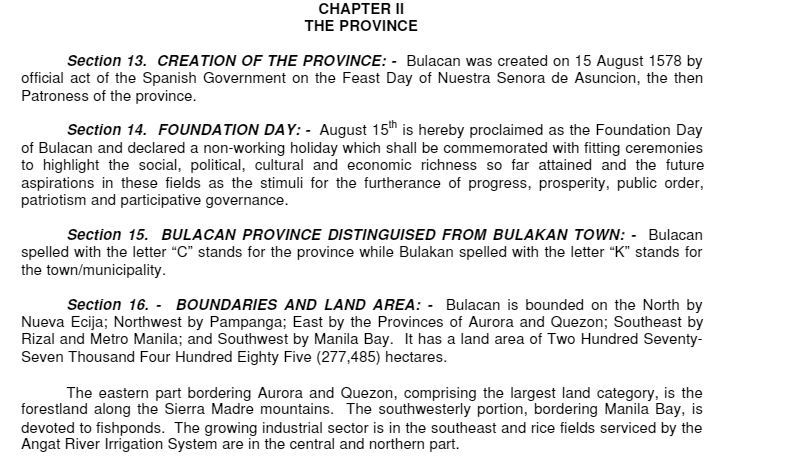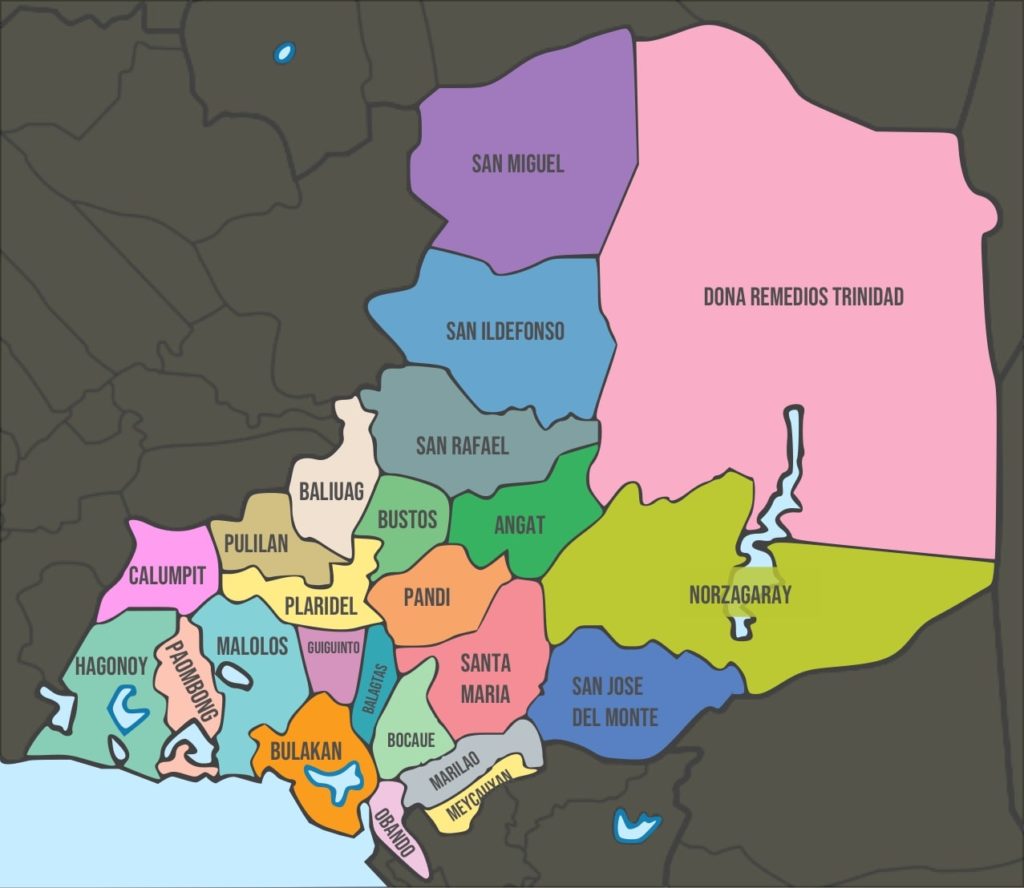Many folks are confused about the spelling of the province of Bulacan (Bulakan) and a town with the same namesake. A namesake is a person, geographic location, building, or other entity with the same name as another or named after another entity that first had the title. The New Manila International Airport (NMIA) is located in the town of Bulacan (Bulakan) in the province of Bulacan (Bulakan). How do we reconcile and distinguish them apart?
Read Discover Bulacan: Land of the Heroes and Bulacan LGUs, residents support NMIA’s immediate construction
Bulacan vs. Bulakan
The original spelling of the name of our province and its namesake town is Bulacan with the letter ‘c.’ This has been the standard since the Spanish occupation, as proven by old geographical maps and historical manuscripts found online.

Bulakan (Bulacan), one of the oldest towns in the Philippines, became the encomienda or capital of the Province of Pampanga (Provincia de la Pampanga) and later became the first capital of the Province of Bulacan before it was moved to Malolos shortly after the American occupation.
The early Bulaqueños residing in Bulacan (Bulakan), the majority of which are Tagalog-speaking folks, engaged in farming, fishing, handicrafts, and weaving.
On February 19, 2007, the Sangguniang Panlalawigan (Provincial Government) of Bulacan headed by then-governor Josefina “Josie” Mendoza-Dela Cruz, enacted Ordinance No. C-004, entitled “An ordinance enacting the new provincial administrative code of Bulacan.”
This ordinance shall be cited as the NEW PROVINCIAL ADMINISTRATIVE CODE OF BULACAN or NEPAC. The NEPAC is an updated compilation and integration of ordinances, resolutions, and Executive Orders passed in 1996 when the original Provincial Administrative Code (Ordinance No. C-001) was enacted.
It includes proactive or predictive legislative measures. It revises in form and substance the original code. Statutes are localized in light of relevancy, efficiency, and uniqueness to local situations. It reflects the aspirations and rising expectations of the constituency. It galvanizes the working relationship between the executive and legislative arms of the Provincial Government, germinating the impetus for excellence in local governance.
NEPAC establishes the new structural framework of the Provincial Government, considering the reorganizations and re-alignments undertaken. It defines the functions, powers, and responsibilities of departments and their personnel to promote best practices, transparency, and accountability.
It promulgates the appropriate linkages in public administration to include the vital role of Non-Government and People’s Organizations as partners in sustainable development. Lastly, it provides the dynamic mechanism for development processes and initiatives, contemplating its use as the primary guiding principle of local public administration and sanggunian legislation.

Under Chapter II Section 15, Bulacan, spelled with the letter “C,” stands for the province, while Bulakan, spelled with the letter “K,” stands for the town/municipality.

Other Significant Sections
- Section 24. PROVINCIAL HERO: – MARCELO H. DEL PILAR is the chosen hero of the province. His monument shall be erected on the center island leading to the Capitol near the MacArthur Highway.
Read On his 170th Birth Anniversary: Fun Facts about Marcelo H. del Pilar (a.k.a. Plaridel)
- Section 25. THE BULACAN MONTH or BUWAN NG BULACAN: – There shall be an annual celebration of the BUWAN NG BULACAN to be held every August 15 to September 15, beginning from the Foundation Day to the anniversary of the Malolos Congress.
- Section 26. THE PROVINCIAL BATTLE CRY: – “Taas Noo Bulakenyo” is the Provincial Battle Cry. It challenges every citizen to walk the extra mile with a clear vision, a noble spirit, and proud to be a Bulakenyo.
- Section 27. THE PROVINCIAL LEGAL HOLIDAYS:
- February 3 – Blas Ople Day
- April 2 – Balagtas Day
- August 15 – Foundation Day
- August 30 – Marcelo H. Del Pilar Day
- September 11 – Araw ng mga Barangay sa Bulacan.
The day declared as a non-working holiday in Malolos City shall also be a non-working holiday for provincial employees.
- Section 28. THE PROVINCIAL TREE: – The Provincial Tree from which the province derived its name shall be the BULAK. It is also known as KAPOK. BULAK trees abound in the area and have been planted along significant roads that started in Meycauayan. Travelers patronizing the white silken fiber of the fruit as materials for pillows and mattresses refer to the source of the materials as BULAKAN, and since then, the province has been known by that name.
- Section 29. THE PROVINCIAL PLANT: – Yerba Buena, scientifically called “Satureja Douglasii,” is the Spanish word for “good grass.” It may be propagated on pots. It has medicinal properties and is used to cure fever, fainting spells, headache, stomachache, and other minor ailments. It is used as the primary seasoning of noodles. It shall be propagated by planting it along the center island in front of the Capitol, which will also serve as part of the continual efforts to beautify the park.

- Section 30. THE PROVINCIAL FLOWER: – Sampaguita, the national flower scientifically known as “Jasminum Sambac,” shall also be the Provincial Flower. Its whiteness symbolizes purity, and its fragrance is the nobility of the race. A garland of Sampaguita is the usual greeting to dignitaries and persons of high rank and prestige. The plant is sturdy, and the flowers are a source of livelihood. The Sampaguita shall be part of the ornamental plants in the Provincial Capitol Park.
- Section 31. THE PROVINCIAL FISH: – The Bangus or milkfish is the Provincial Fish. It is known scientifically as “Chanos-chanos.” It is the primary product of the fish industry of the province. Its production generates the substantial livelihood of not a few constituents in the towns of Hagonoy, Paombong, Obando, Meycauayan, Malolos, Bocaue, and Calumpit.
- Section 32. THE PROVINCIAL CULTURAL DANCE: – The Provincial Cultural Dance shall be the “Pandanggo kay Sta. Clara”. It is the street dance in a procession of Santa Clara during her feast day on May 18 in Obando by childless women, believing that in their participation, they would be blessed and their wish for motherhood fulfilled. The festival draws not only devotees but tourists as well, adding to the cultural legacy of the province.
- Section 33. THE PROVINCIAL FRUIT: – The mango or mangga in Pilipino and scientifically called “Mangifera indica,” is the Provincial Fruit because of its varied uses, from its early stage or the greening phase to its ripening into golden sweetness. It can be eaten as dessert and as condiments to recipes. Pregnant women often crave its sweet-sour taste.
- Section 34. THE PROVINCIAL ANIMAL: – The carabao or water buffalo, a beast of burden, the farmer’s most precious possession for work, meat, and milk, is the Provincial, Animal. It can be taught to kneel revere to the gods and to race to the public’s delight during fiestas and rural celebrations. The carabao in concrete shall be erected in front of the Provincial Agriculture Office to enhance its significance.
Sources:
- Lizaso, N. J. (2021, January 13). Bulakan with a K. Manila Bulletin. Retrieved September 5, 2022, from https://mb.com.ph/2021/01/13/bulakan-with-a-k/
- Balbin, M. (2022, August 15). Bulakenyos urged to Relearn Province’s cultural history . Philippine News Agency. Retrieved September 16, 2022, from https://www.pna.gov.ph/articles/1181393
- Balbin, E. (2022, August 15). Villanueva, Fernando led the 444th Bulacan Foundation Day celebration. Ronda Balita. Retrieved September 16, 2022, from https://rondabalita.net/47219/